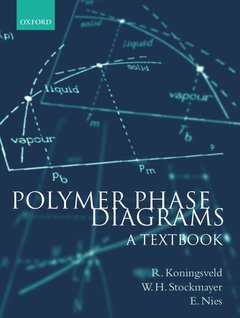Polymer Phase Diagrams A Textbook
Langue : Anglais
Auteurs : Koningsveld Ronald, Stockmayer Walter H., Nies Erik

Polymeric materials include plastics, gels, synthetic fibres, and rubbers. They are all-important both in industry and in daily life. Unlike liquid water, ice, or sugar solution, polymers are not homogeneous. They are said to consist of two or more phases, and their production and processing, as well as their properties and uses, depend on an understanding of the transitions that take place between these phases. Over the last two decades, phase diagrams of considerable complexity have begun to appear in polymer literature. Phase transitions occur abundantly in polymer production and processing, are often encountered in polymer research, or are instrumental in laboratory methods of polymer characterization. This new textbook uses fundamental principles to classify phase separation phenomena in polymer systems, and describes simple molecular models explaining the observed behaviour. It supplies insight in the reading and construction of complex phase diagrams, as well as an understanding of the relationships that must exist between different phase transitions. Containing hundreds of diagrams, exercises at chapter ends, and several useful appendices, this text should be useful for anyone teaching or studying a course in polymer science.
Preface, Glossary of symbols, PART. Principles of Heterogeneous Equilibrium, 1: Single-component systems, 2: Mixtures, 3: Binary systems, Bakhuis-Roozeboom Diagram, 4: Binary systems, partial miscibility in the liquid phase, and supercritical phenomena, 5: Binary systems, solid solutions, and compounds, 6: Ternary and multicomponent systems, PART. Simple Modelling, 7: Modelling partial miscibility and solid/liquid equilibrium, PART. Heterogeneous equilibrium in macromolecular systems, 8: Introduction, 9: Partial miscibility of strictly-binary polymer systems, 10: Partial miscibility of quasi-binary polymer systems, 11: The influence of pressure, 12: Solid/liquid equilibrium, 13: Quasi-ternary polymer systems, 14: Fractionation of polymers, 15: Miscellaneous phase transitions, Appendices, Appendix 2 - Simple modelling for small-molecule systems, Appendix 3 - Calculation of cloudpoint, shadow, and coexistence curves, Appendix 4 - Simple modelling of equilibria in polymeric systems, Appendix 5 - Numerical evaluations of interaction parameters, Appendix 6 - Molecular basis of the interaction parameter, Appendix 7 - Answers for exercises
Advanced undergraduate and graduate students taking courses in polymer science. Also of interest to materials scientists, physicists, and chemical engineers, and to researchers in the polymer industry.
Professor Ronald Koningsveld, President- Kennedy Singel 5/5, 6137 AA Sittard, Netherlands Phone/Fax 31-46-4529772 Prof Walter H Stockmayer, Chemistry Department, Dartmouth College, Hanover NJ 03755, USA Dr Erik Nies, Technical University Eindhoven, Chemical Technology, Polymer Chemistry, Eindhoven, Netherlands.
Date de parution : 03-2001
Ouvrage de 360 p.
18.8x25.1 cm
Thèmes de Polymer Phase Diagrams :
© 2024 LAVOISIER S.A.S.



